If you're looking for a fun outdoor game for summer, chances are you're considering cornhole. Cornhole is a tossing game in which teams of two compete, trying to throw fabric bean bags into a hole on a wooden board. If you're on a budget, making your own cornhole bags is a simple project You'll just need a few supplies and basic sewing skills.

Video of the Day
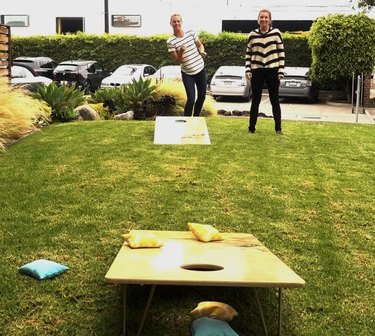
Things You'll Need
1/2 yard of Color A duck canvas or other outdoor fabric
1/2 yard of Color B duck canvas or other outdoor fabric
Ruler
Fabric scissors
Pins
Sewing machine
Thread to match Color A and Color B fabric
Pencil (optional)
Sewing needle
8 pounds of feed corn or other filler of your choice
Step 1
Cut the fabric into eight 7-inch squares of Color A and eight 7-inch squares of Color B. Note that the regulation size for cornhole bags is 6 inches square. This will be the finished measurement after you sew the bean bags.

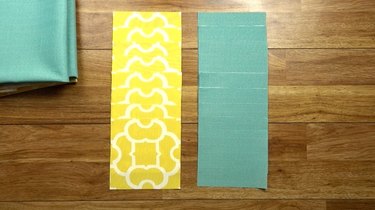
Step 2
Place two squares of Color A fabric right-sides together. Pin around the square to hold in place.
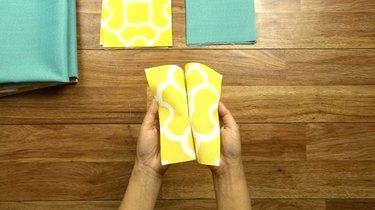
Step 3
Thread the sewing machine (or sewing needle) with thread to match the Color A fabric. Sew straight, short stitches using a 1/2-inch seam allowance starting about 2 inches from any corner and ending 2 inches from where you began sewing. You should have a seam around three sides of the square, with a 2-inch opening on one side of the square for filling later. Then, stitch again over the first stitch line to reinforce the seam. Stitching twice will prevent your bag from bursting open when thrown.
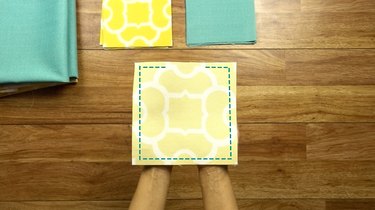
Step 4
Repeat steps 2 and 3 with the remaining squares of Color A fabric; then repeat steps 2 and 3 with the eight squares of Color B fabric. You should have a total of 8 bean bags when you are finished sewing.
Step 5
Snip the corners (taking care not to snip through the seams), then turn each bean bag right-side out. Use an unsharpened pencil to poke the corners out if necessary.

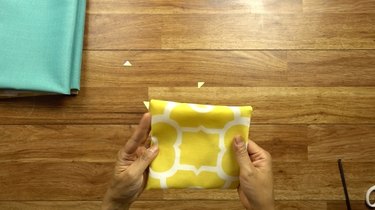
Step 6
Place the empty bean bag on a kitchen scale, then fill each bean bag with feed corn or other filler of your choice (see "Choosing Bean Bag Fillers" below) until the entire bag weighs exactly one pound.
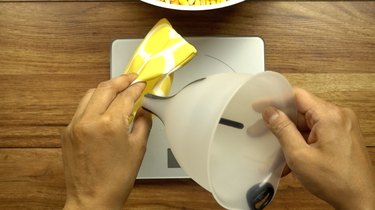

Step 7
If hand sewing, thread a needle with matching thread and sew the open gap of each bean bag with small running stitches to close, sewing as close to the edge as possible (about 1/16 - 1/8 of an inch). Stitch again over the first stitches to reinforce the seam. If using a machine, push the corn as far down from the opening as possible, then secure the corn in place using pins (see image below) to prevent any corn from obstructing your machine needle. Seam the bag shut twice to reinforce the closure.
Tip
- If you do not have access to a sewing machine, you can sew the cornhole bags by hand with a needle and thread. Just be sure that you are using short, even stitches to make the bags as durable as possible.
- Use a sewing needle that's appropriate for heavier outdoor fabrics; otherwise, the needle may break in the machine.

Choosing Bean Bag Fillers
When it's time to fill your bean bags, you have several different options depending on your needs and who will be playing the cornhole game.
Feed Corn
Best for: Players who want to go the traditional route
Feed corn is the traditional filler, giving the cornhole game its name. If you've ever played with a feed corn bean bag, you may have also noticed that the feed corn causes dust to rise from the bag. This is the corn breaking down inside the bag, which also allows the bag to slide across the cornhole board.
Plastic Pellets
Best for: Players who want cornhole bags to last longer
Plastic pellets are available in a size similar to feed corn; however, plastic pellets won't break down like corn. Plastic pellets are also resistant to water, mold and insects, making the bean bags last longer.
Dried Beans
Best for: Players on a budget
Beans are an inexpensive option for filler. If you decide to use dried beans for your bags, choose a bean that is similar in size to corn such as baby lima, pinto or split pea.
Warning
Dried beans will attract unwanted pests such as insects. If you fill your cornhole bags with beans, consider storing the bags indoors in a sealed container when you're not using them.
Dry Rice
Best for: Young players who need a lighter bag
Like dried beans, rice is an inexpensive filler. Rice's light weight will result in a bag that's much easier to throw than one filled with corn, making it ideal for small children to play with.